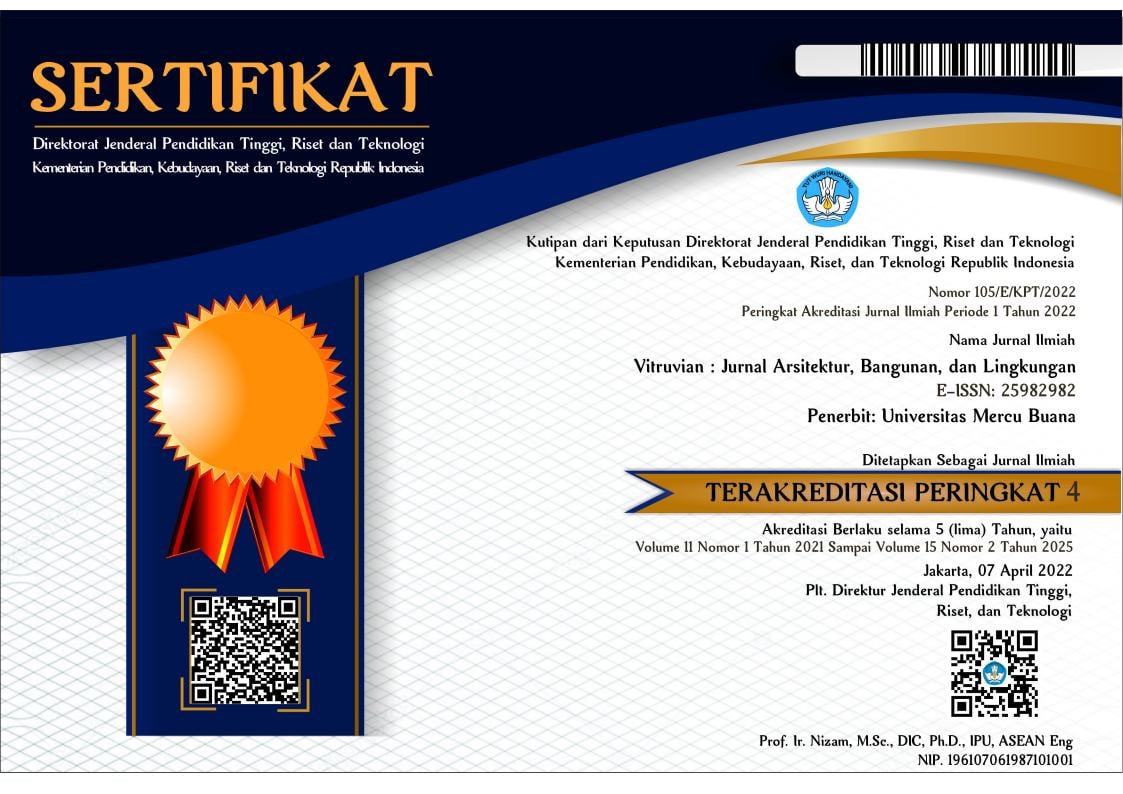PELESTARIAN DAN PENGELOLAAN KAWASAN PUSAKA BERBASIS KOMUNITAS: KAJIAN TEORITIK
Abstract
Pelestarian dan pengelolaan pusaka merupakan hal yang penting untuk menjamin keberlanjutan pusaka untuk generasi mendatang. Pelestarian dan pengelolaan pusaka di Indonesia seringkali tidak dilakukan secara bersama-sama antara pemangku kepentingan dan komunitas sehingga pelestarian dan pengelolaanya tidak berhasil, padahal keterlibatan komunitas dapat menjamin keberhasilannya. Penelitian ini bertujuan menelusuri mengenai pengelolaan pusaka berbasis komunitas berdasar kajian penelitian terdahulu sekaligus mengetahui tahapan yang dilakukan dalam pelestarian dan pengelolaan berbasis komunitas. Hasil kajian menunjukan ada tiga tahapan yang dilakukan yaitu; peningkatan kesadaran pusaka komunitas, keterlibatan komunitas dalam kebijakan dan kerja sama komunitas dan pemangku kepentingan. Ketiganya dilakukan untuk mencapai tujuan pelestarian dan pengelolaan pusaka berkelanjutan.
Keywords
Full Text:
PDF (Bahasa Indonesia)References
Abdussamad, Z. (2022). Konstruksi Sosial Pengelolaan Lingkungan Alam Berbasis Kearifan Lokal Pada Masyarakat Adat Suku Boti. Universitas Muhammadiyah Malang.
Adishakti, L. T. (2014). KOTA PUSAKA SEBAGAI PEMBANGKIT EKONOMI KREATIF DI INDONESIA. https://chc.ft.ugm.ac.id/wp-content/uploads/sites/397/2020/04/2014-Adishakti-Kota-Pusaka-Buku-Putih-.pdf
Adishakti, L. T. (2016). PENGANTAR PELESTARIAN PUSAKA. https://chc.ft.ugm.ac.id/wp-content/uploads/sites/397/2020/04/2016-PENGANTAR-PELESTARIAN-PUSAKA-1.pdf
Adishakti, L. T. (2017). Pelestarian & Pengelolaan Kota Pusaka. Pusat Pengembangan Kawasan Perkotaan BPIW, Kementerian Pekerjaan Umum dan Perumahan Rakyat.
Aisiah, A., Suhartono, S., & Sumarno, S. (2016). The measurement model of historical awareness. Research and Evaluation in Education, 2(2), 108. https://doi.org/10.21831/reid.v2i2.8399
Al Haija, A. A. (2011). Jordan: Tourism and conflict with local communities. Habitat International, 35(1), 93–100. https://doi.org/10.1016/j.habitatint.2010.04.002
Alexopoulos, G. (2013). Management of living religious heritage: Who sets the agenda? The case of the monastic community of Mount Athos. Conservation and Management of Archaeological Sites, 15(1), 59–75. https://doi.org/10.1179/1350503313Z.00000000047
Al-hagla, K. S. (2010). Sustainable urban development in historical areas using the tourist trail approach: A case study of the Cultural Heritage and Urban Development (CHUD) project in Saida, Lebanon. Cities, 27(4), 234–248. https://doi.org/10.1016/j.cities.2010.02.001
Arnstein, S. R. (1969). A Ladder Of Citizen Participation. Journal of the American Institute of Planners, 35(4), 216–224. https://doi.org/10.1080/01944366908977225
Aziz, N. A. A. (2022). The Comparison of the Best Practices of the Community-Based Education for Living Heritage Site Conservation. Lecture Notes in Civil Engineering, 161(Query date: 2022-09-14 13:33:32), 1–8. https://doi.org/10.1007/978-981-16-2329-5_1
Aziz, N. A. A., Ariffin, N. F. M., Ismail, N. A., Ismail, S., Alias, A., & Utaberta, N. (2022). The Comparison of the Best Practices of the Community-Based Education for Living Heritage Site Conservation. In L. Yola, U. Nangkula, O. G. Ayegbusi, & M. Awang (Eds.), Sustainable Architecture and Building Environment (Vol. 161, pp. 1–8). Springer Singapore. https://doi.org/10.1007/978-981-16-2329-5_1
Bandarin, F. (2019). Reshaping Urban Conservation. In A. Pereira Roders & F. Bandarin (Eds.), Reshaping Urban Conservation (Vol. 2, pp. 3–20). Springer Singapore. https://doi.org/10.1007/978-981-10-8887-2_1
Bolici, R. (2020). Reusing built heritage. Design for the sharing economy. Research for Development, Query date: 2022-07-18 14:02:46, 315–324. https://doi.org/10.1007/978-3-030-33256-3_29
Cheng, E. W., Li, A. H. F., & Ma, S. (2014). Resistance, Engagement, and Heritage Conservation by Voluntary Sector: The Case of Penang in Malaysia. Modern Asian Studies, 48(3), 617–644. JSTOR.
Chitty, G. (Ed.). (2016). Heritage, Conservation and Communities: Engagement, participation and capacity building (0 ed.). Routledge. https://doi.org/10.4324/9781315586663
Cina’, G., Demiröz, M., & Mu, Q. (2019). Participation and conflict between local community and institutions in conservation processes: The case of Novara Old Town. Journal of Cultural Heritage Management and Sustainable Development, 9(2), 134–148. https://doi.org/10.1108/JCHMSD-05-2018-0038
Cole, S. (2006). Information and Empowerment: The Keys to Achieving Sustainable Tourism. Journal of Sustainable Tourism, 14(6), 629–644. https://doi.org/10.2167/jost607.0
Cots, E. G. (2011). Stakeholder social capital: A new approach to stakeholder theory. Business Ethics: A European Review, 20(4), 328–341. https://doi.org/10.1111/j.1467-8608.2011.01635.x
Dormaels, M. (2016). Participatory management of an urban world heritage site: The Table de Concertation du Vieux-Québec. Journal of Cultural Heritage Management and Sustainable Development, 6(1), 14–33. https://doi.org/10.1108/JCHMSD-11-2014-0038
Fidler, R. Y., Ahmadia, G. N., Amkieltiela, Awaludinnoer, Cox, C., Estradivari, Glew, L., Handayani, C., Mahajan, S. L., Mascia, M. B., Pakiding, F., Andradi-Brown, D. A., Campbell, S. J., Claborn, K., De Nardo, M., Fox, H. E., Gill, D., Hidayat, N. I., Jakub, R., … Harborne, A. R. (2022). Participation, not penalties: Community involvement and equitable governance contribute to more effective multiuse protected areas. Science Advances, 8(18), eabl8929. https://doi.org/10.1126/sciadv.abl8929
Fitri, I., Ahmad, Y., & Ratna, N. (2019). Local Community Participation in Establishing the Criteria for Heritage Significance Assessment of the Cultural Heritage in Medan. Kapata Arkeologi, 15(1), 1. https://doi.org/10.24832/kapata.v15i1.523
ICOMOS. (1965). INTERNATIONAL CHARTER FOR THE CONSERVATION AND RESTORATION OF MONUMENTS AND SITES (THE VENICE CHARTER 1964). ICOMOS, Paris. https://www.icomos.org/charters/venice_e.pdf
ICOMOS, C. (1982). Charter for the preservation of Quebec’s Heritage.
Jokilehto, J. (1994). Authenticity: A general framework for the concept. NARA CONFERENCE ON AUTHENTICITY in Relation to the World Heritage Convention. NARA CONFERENCE ON AUTHENTICITY, Nara, Japan.
Jokilehto, J. (2011). A history of architectural conservation (Repr). Routledge.
Kerr, J. S. (2013). Conservation plan: A guide to the preparation of conservation plans for places of European cultural significance (Seventh edition). Australia ICOMOS, International Council on Monuments and Sites.
Kyriakidis, E. (2019). A community empowerment approach to heritage management: From values assessment to local engagement. Routledge.
LeBlanc, F. (1993). Is Everything Heritage? ICOMOS Canada Bulletin, 2(2), 2–3.
Li, Y., & Hunter, C. (2015). Community involvement for sustainable heritage tourism: A conceptual model. Journal of Cultural Heritage Management and Sustainable Development, 5(3), 248–262. https://doi.org/10.1108/JCHMSD-08-2014-0027
Mann, M. (2000). The community tourism guide: Exciting holidays for responsible travellers (1st. ed). Earthscan.
McMillan, D. W., & Chavis, D. M. (1986). Sense of community: A definition and theory. Journal of Community Psychology, 14(1), 6–23. https://doi.org/10.1002/1520-6629(198601)14:1<6::AID-JCOP2290140103>3.0.CO;2-I
Ngulube, P. (Ed.). (2018). Handbook of Research on Heritage Management and Preservation: IGI Global. https://doi.org/10.4018/978-1-5225-3137-1
Poulios, I. (2014). The past in the present: A living heritage approach, Meteora, Greece. Ubiquity Press.
Satoh, S. (2019). Evolution and methodology of Japanese machizukuri for the improvement of living environments. Japan Architectural Review, 2(2), 127–142. https://doi.org/10.1002/2475-8876.12084
UNESCO. (2019). Living Heritage and Education. UNESCO.
Ville de Montréal. (2005). HERITAGE POLICY.
Wahyuni, D. (2018). STRATEGI PEMBERDAYAAN MASYARAKAT DALAM PENGEMBANGAN DESA WISATA NGLANGGERAN, KABUPATEN GUNUNG KIDUL. Aspirasi: Jurnal Masalah-Masalah Sosial, 9(1), 83–100.
Watanabe, S. J. (2006). Machizukuri in Japan: A historical perspective on participatory community-building initiatives. In Cities, Autonomy, and Decentralization in Japan (Reprinted, pp. 128–138). Routledge.
Wijayanto, P. (2016). BUILDING THE NOTION OF HERITAGE CITY IN INDONESIA: THE ROLE OF LOCAL GROUP COMMUNITIES. THE HERITAGE OF ANCIENT AND URBAN SITES: GIVING VOICE TO LOCAL PRIORITIES, Singapore.
Wijesuriya, G. (2015). Living Heritage. ICCOROM.
Winandari, M. I. R., Wijayanto, P., Safitri, R. A., Bhirawa, B., Fitrianto, A. W., & Ischak, M. (2022). PENGARUH GERAKAN PELESTARIAN PUSAKA TERHADAP ADAPTASI BANGUNAN BERSEJARAH DI KOTA LASEM. 20.
Yang, R. J. (2014). An investigation of stakeholder analysis in urban development projects: Empirical or rationalistic perspectives. International Journal of Project Management, 32(5), 838–849. https://doi.org/10.1016/j.ijproman.2013.10.011
DOI: http://dx.doi.org/10.22441/vitruvian.2023.v12i3.005
Refbacks
- There are currently no refbacks.
Copyright (c) 2023 Vitruvian : Jurnal Arsitektur, Bangunan dan Lingkungan
License URL: http://publikasi.mercubuana.ac.id/index.php/virtuvian/article/view/20088
Layout Jurnal Vitruvian:Download
Declaration & CTA Form Vitruvian:Download
(WAJIB DI UPLOAD SEBAGAI SUPLEMENTARY SAAT SUBMIT ARTIKEL)
Vitruvian
Program Studi Arsitektur
Fakultas Teknik Universitas Mercu Buana
Jl. Raya Meruya Selatan, Kembangan, Jakarta 11650
Tlp./Fax : +62215871335
Surel : [email protected]
p-ISSN : 2088-8201
e-ISSN : 2598-2982
Website : http://publikasi.mercubuana.ac.id/index.php/virtuvian
DOI : 10.22441/vitruvian
Vitruvian is indexed by the following abstracting and indexing services:

This work is licensed under a Creative Commons Attribution-NonCommercial 4.0 International License.








